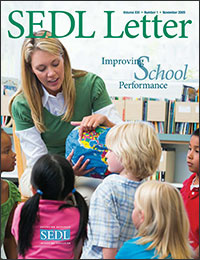Helping Texas Teachers Support English Language Learners
The number of English language learners (ELLs) in our nation’s public schools has skyrocketed over the past decade and continues to grow. Ensuring the academic success of these students is a critical component of school improvement. Under the No Child Left Behind Act of 2001 (NCLB), public schools are rated on the performance of all students, including ELLs. More than ever, educators face the challenge of ensuring that ELLs receive the support they need to succeed academically and in life.
In Texas, SEDL’s Texas Comprehensive Center (TXCC) is helping state educators meet this challenge. The TXCC is one of two comprehensive centers that SEDL operates (the other is the Southeast Comprehensive Center). The comprehensive centers are charged with building the capacity of state education agencies and statewide systems of support so that they can better help underperforming schools and districts close achievement gaps.
In 2008, the TXCC received supplemental funding from the U.S. Department of Education to help the Texas Education Agency (TEA) build the capacity of schools and districts to meet the instructional needs of ELLs. Working side by side with the TEA in a consultative role, the TXCC is providing technical assistance, professional development, and research to help educators select the appropriate linguistic accommodations for ELLs in Texas.
Challenges for Supporting ELLs in Texas
Texas has good reason to focus on the quality of its ELL programs. The number of ELLs enrolled in the state’s public schools has risen dramatically over the past decade, a trend that parallels what is happening nationally. In 2008, more than 800,000 students—nearly 15% of K–12 students in Texas’ public schools—were ELLs (TEA Student Assessment Division, 2009). Moreover, ELLs often experience lower graduation rates and scores on the state proficiency exam, the Texas Assessment of Knowledge and Skills (TAKS).
Before the TXCC and TEA undertook this project, educators in Texas already had improved instructional support for ELLs. In accordance with NCLB, all Texas teachers who instruct ELLs must implement both the state’s English Language Proficiency Standards (ELPS) and its academic standards, the Texas Essential Knowledge and Skills (TEKS). Texas also has aligned its English language and academic standards with the Texas English Language Proficiency Assessment System, which is used to assess a student’s English language proficiency level and progress in the domains of speaking, listening, reading, and writing. The results determine the linguistic accommodations the student may receive during instruction and on assessments.
The TEA provides guidelines to help teachers select and implement appropriate linguistic accommodations during instruction and on the version of the TAKS that has accommodations for limited English proficient (LEP) students. In addition, Language Proficiency Assessment Committees help local education agencies determine the needs of ELLs, select instructional interventions, monitor student progress, make assessment decisions, and maintain required documentation.
Even with this guidance, however, Texas educators face a number of challenges in meeting the needs of ELLs. Many content-area teachers are unfamiliar with the ELPS and have only a superficial knowledge of the types of linguistic accommodations needed to meet them. Furthermore, while the linguistic accommodations provided on state assessments are fairly consistent among teachers, those provided during instruction vary widely.
In working with the TXCC to improve support for ELLs, the TEA determined that schools and districts need more guidance and professional development in making consistent decisions about linguistic accommodations. This consistency is needed to ensure that ELLs receive equal access to a challenging curriculum and an equal opportunity to learn and demonstrate what they know.
The TXCC and TEA identified three main needs:
- Building the capacity of districts and schools in following the TEA guidelines for selecting assessments and linguistic accommodations for LEP students
- Providing assistance to ensure that the same linguistic accommodations provided to LEP students on assessments are also provided in instruction
- Providing assistance in using the results of state assessment data to learn which linguistic accommodations best ensure that ELLs are able to demonstrate their level of achievement
Regional Comprehensive Centers
|
|
ELL Focus Groups
In early 2009, during the first phase of the Texas ELL project, a team of TXCC staff conducted 14 focus groups across the state to learn how districts and schools make decisions about ELL accommodations. Focus group participants included teachers, campus administrators, district-level staff, department chairs, content coordinators, testing coordinators, and directors of bilingual/English as a second language (ESL) programs. Although some focus groups included participants from only one district, most included representatives from a number of districts addressing linguistic accommodations in different ways.
With each focus group, facilitators used a protocol containing the same questions. Participants first discussed ELL practices and services at the district and school levels. Discussion then moved to questions about professional development and the role of the district and state in providing guidance on linguistic accommodations.
Haidee Williams, a project director at SEDL and director of the Texas ELL project, reflects on the value of the focus groups. “We talked to practitioners about the challenges they faced when working with ELLs and what their needs were. We found out what is really going on in the field and used that to shape our work.”
Focus group responses varied both across and within districts and showed the complexity and variation of ELL services in Texas. Some districts and schools with long-established ESL programs reported that their main challenge often is getting students and parents to place enough emphasis on learning English in a community where Spanish is spoken widely. Other participants reported having students who speak languages other than Spanish, such as Arabic, Farsi, and Russian. Still other participants were from districts with small ELL populations and noted that they often lacked the funding to provide adequate instructional support. Some districts reported that their teachers primarily make decisions about the proper use of linguistic accommodations; in other districts, leaders or other staff are the main decision makers.
Focus Group Themes
Facilitators identified the following cross-cutting themes in focus group responses:
|
ELL Research Summit
To build on the results of the focus groups, the TXCC and TEA, in partnership with the Center on Instruction, held a 2-day research summit titled “Making Consistent Decisions About Accommodations for English Language Learners.” The summit took place in March 2009 at SEDL headquarters in Austin, Texas.
The research summit’s purpose was to review the findings from the focus groups, learn from the research of ELL experts, and stimulate dialogue among researchers and state leaders on how best to help educators select and implement ELL accommodations. Four essential questions guided the dialogue:
- What do research and best practice tell us about selecting and implementing linguistic accommodations in instruction and on assessments for English language learners?
- What is the state of current practice in the selection and use of linguistic accommodations in instruction and on assessments for English language learners?
- Where should we begin in helping educators select and provide appropriate linguistic accommodations for English language learners in instruction and on assessments?
- What questions require further study with regard to linguistic accommodations for English language learners in instruction and on assessments?
A panel of seven experts spoke; Dr. David Francis, director of the Center on Instruction ELL strand, served as the discussant. In addition, TEA staff gave a presentation on the state’s current ELPS and guidelines regarding ELL accommodations. Summit participants then broke into small groups to reflect on what they learned from the panel presentations and focus group summaries.
SEDL program director Vicki Dimock, who directs the TXCC, explains, “The summit presented an opportunity for an in-depth dialogue among researchers, policymakers, and practitioners as a means for bringing evidence to bear on practice, which has long been a focus of the work of the TXCC and SEDL.”
The outcomes of the summit helped the TXCC and TEA team determine how best to improve ELL support in Texas. “The presentations and reflective dialogue of the summit,” says Williams, “helped identify priorities about how the TXCC could best assist the TEA in providing a clear and consistent message to districts and schools on the appropriate selection and implementation of linguistic accommodations for ELLs.”
Collaborating to Put Research Into Practice
TXCC and TEA staff used the findings of the research summit to inform the development of a plan to standardize the selection and implementation of ELL accommodations across the state. The plan involves three phases:
- Collect and analyze data about ELLs and the linguistic accommodations used on the TAKS and their impact.
- Clarify the criteria for selecting appropriate linguistic accommodations for instruction and assessment based upon student characteristics (e.g., level of English proficiency), content area, and grade level.
- Create an online professional development course to build state educators’ capacity to make consistent, data-based decisions regarding the use of ELL accommodations in instruction and on state assessments.
 The TXCC is working with an outside developer to create the introductory online course, which will help educators understand the need for linguistic accommodations, explore what linguistic accommodations during instruction actually look like in practice, and learn the state requirements for integrating the ELPS.
The TXCC is working with an outside developer to create the introductory online course, which will help educators understand the need for linguistic accommodations, explore what linguistic accommodations during instruction actually look like in practice, and learn the state requirements for integrating the ELPS.
“This project has merged findings from focus groups and research in an applied approach to increase knowledge and awareness of the importance of using linguistic accommodations with English language learners,” explains Dr. Mabel Rivera, deputy director of the Center on Instruction’s ELL strand and one of the presenters at the research summit. “The online module will bring all concepts to life, as teachers will have access to definitions, resources, and virtual experiences on how to decide and implement linguistic accommodations depending on the students’ level of proficiency in English.”
Roberto C. Manzo, program specialist for TEA’s School Readiness and Partnerships division, says, “We hope all administrators and teachers hear about this great online resource for our ELL students.”
During the coming year, the TXCC will continue to work with a cross-division team of TEA staff on the ELL initiative. Future plans include developing additional online courses for teachers, as well as an asset map of the TEA initiatives and programs that focus on ELLs. The TEA also plans to provide professional development for educators regarding the ELPS and the availability of the new online course. In addition, the TXCC plans to expand the ELL section on its Web site to provide research-based knowledge and strategies to support the state’s capacity to assist districts and schools in the instruction of ELLs.
“In summary,” says Williams, “this project is an example of how the TXCC is working to address both its objective to increase and strengthen the knowledge, skills, and resources needed for school improvement and SEDL’s mission to solve significant problems facing educational systems and communities to ensure a quality education for all learners.”
Reference
- TEA Student Assessment Division, Title III Management Institute. (2009). ELL statewide assessment update: Where we are and where we’re headed. Retrieved from http://ritter.tea.state.tx.us/student.assessment/resources/conferences/esl/Apr_09_TitleIII_MI_ELL.ppt#3
Next Article: SEDL News


